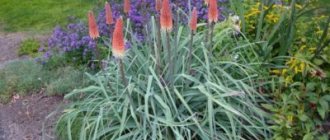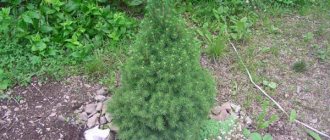- February 16, 2019
- Flowers
- Marina Olenyuk
Let's devote a few minutes of our time to learning how to plant a very interesting plant in your flower garden - periwinkle. Photos, planting and caring for flowers in open ground conditions is the topic of our article today. In addition, we will find out why the plant is so loved not only by flower growers themselves, but also by those who simply admire garden flower beds and other cozy places where it is available.
Why do they love him?
Each plant, including the above-mentioned flower, has something to the gardener’s liking. For some, these are gorgeous flowers of incredible beauty, for others - a garden filled with fragrant plants that bloom in the evenings and give off their delightful flair. Why do gardeners resort to improving the area with this plant, wondering how to properly grow periwinkle. Care and planting in open ground is a very controversial issue.
No, it does not have the most luxurious inflorescences (although it is quite pretty), and its aroma will not turn your head. But many people cannot imagine a cozy place in their garden without a specimen of this plant. There are still many gardeners who believe that periwinkle flowers have magical powers and drive away the evil eye from the inhabitants of the home in whose flowerbed a periwinkle bush grows. Periwinkle, which has its own nuances when planted and cared for outdoors in cooler parts of the world, is liked for its delicate beauty of flowers and evergreen leaves.
Appearance of the plant and some features
Periwinkles have glossy dark green leaves. They are shiny and have a dense structure, as if covered with a coating of wax. The bushes themselves often fall to the ground: they have the structure of a creeping plant. In most cases, periwinkle overwinters well under a blanket of snow. Planting and care in open ground should be done where there are no too catastrophic drops in temperature in winter - this is the condition of the plant. In unsuitable temperature conditions, your plant will most likely become stunted or even freeze out during the harsh winter.
What shades does the periwinkle flower have, which today's gardeners are concerned about planting and caring for? The plant blooms in most cases with bluish flowers. Purple and lilac - often found in a flower bed with catharanthus (that’s its second name). White flowers, as well as soft cream and pink, can also be found in some specimens of the subshrub. Funnel-shaped flower corollas have an elongated tube growing from the leaf axils.
Description
Periwinkle is a perennial plant. The ground cover crop is beautifully lined with a bright carpet in the flower beds. If you plant periwinkle in a flower garden, this will solve problems with weeds. The plant grows quickly, covering the ground. Therefore, the weeds have no chance.
Opposite leaves have a smooth, shiny surface. Even under a layer of snow, the leaves remain fresh and green, since periwinkle is an evergreen crop.
Single flowers are funnel-shaped. Colors: blue, blue, lilac. To date, breeders have developed many varieties with a variety of flower colors.
Where to place periwinkle in the garden
The plant is considered not capricious and can grow tolerably on soils of any acidity and structure. But despite this, the flower has its own preferences. Taking them into account, the gardener will admire more juicy and abundantly blooming specimens. It is better to provide periwinkle planting and care in open ground in a shaded place.
If your plant is variegated (has variegation on the leaves), it is preferable for it to be in a brighter place. However, make sure that the midday sun does not burn the young bush and scorch the flowers. The optimal place to plant periwinkle is under pear and apple trees. The root systems of the tree and the plant live happily together, and the tree does not suppress the catharanthus.
Soil for the plant
A swamp is not the best place for this flower, so we immediately exclude swampy and too heavy saline areas of your garden from likely places. It is preferable to plant and care for periwinkle in open ground on loose soils. Soil that has a neutral reaction is more loved by catharanthus. Slightly acidified soils are also suitable for flowers, but here you may not observe such lush flowering.
Gardeners and flower growers are often faced with the fact that their plot has poor soil with poor structure. This problem can be corrected by adding mature compost during preparatory gardening work.
Catharanthus also does not like areas that are too dry. Try to water your plant regularly, especially during the period of buds and vigorous flowering.
Trimming
Periwinkle Sicily has a high growth rate, so it requires periodic pruning. Otherwise, it will take over a large area and interfere with neighboring plants. Pruning is carried out in early spring. This procedure allows you to form a good crown and promotes the formation of buds. When the flowering period ends, the Sicily periwinkle needs a haircut. The plant is removed from creeping branches and stems, which can later be used for propagation.
Periwinkle. Planting and caring for a flower: general rules
Many people are concerned about the question of how to approach this plant and grow it in their garden. Is it worth planting cuttings or, on the contrary, is it preferable to use seeds? Catharanthus, under favorable conditions, can be propagated in various ways. We will leave the more preferable one to the choice of flower growers.
Depending on the climate zone in which your flower garden is located, choose the methods described below. The main rule when planting and caring for periwinkle is not to leave the plant in the soil over the winter if the winters in your region cannot be called mild. And such specimens need to be planted after the snow melts. In regions with severe temperatures, planting is carried out only after all return frosts have passed.
Varieties
12 plant species have been found and studied in nature . Breeders added their contribution and presented flower growers with a large number of decorative varieties of periwinkle. We will tell you about the most common ones, providing you with photos and descriptions of plants.
Lesser periwinkle (Vinca minor)
The evergreen periwinkle has long, up to 1 meter, creeping stems, densely dotted with small green leaves. Its flowers are painted in all shades of blue.
Large (Vinca major)
The large periwinkle is the largest representative of the genus. The stem and leaves of the plant are covered with sparse hairs.
The length of the leaf blade varies from 3 to 9 cm. The diameter of the flower is 5 cm, the color is from light blue to dark purple. The middle of the flower is white.
Attention! Large periwinkle blooms from May to September with a short break.
Herbaceous (Vinca herbacea)
Herbaceous periwinkle is a deciduous plant species. It does not tolerate severe frosts well, so it needs reliable shelter for the winter.
It can often be found near roads and in oak groves. The stems of the flower cover the ground less frequently than those of the small periwinkle. Flowers can be blue, light blue or purple. Diameter - 3 cm. The main flowering time is May.
Pubescent (Vinca pubescens)
This type of flower lives in the western Caucasus and in the vast forests of Primorye. Loves open spaces.
It is fixed on the ground, spreading roots from creeping stems. The flowers are colored in various shades of blue.
Important! In winter he needs shelter.
Pink (Vinca rosea)
Pink periwinkle, or catharanthus, has been identified by scientists as a separate genus due to the large number of its species (8 pieces).
Unlike the large and small periwinkles, this species grows in bushes with erect stems. They can reach a height of 60 cm. The leaves are glossy, dark green, 7 cm in length.
Seed method (before winter)
Planting and caring for perennial periwinkle, which reproduces by seeds, are the same as for many plants that live for more than one year. This method can be mastered by very patient and passionate flower growers. You will have to wait at least two years for a real riot of colors. In the first year of its flower life, catharanthus will not bloom: it needs strength to grow and form a root system.
How we will sow:
- We pre-treat the soil: we remove weeds and dig up the area where the periwinkles will live.
- We create small grooves. Their depth is two or three centimeters. The degree of deepening depends on the severity of the soil. There should be a distance of ten centimeters between the furrows themselves in which we will sow the seeds. Do not thicken the crops!
- Sow the furrows (not thickly), lightly sprinkle with soil and moisten it.
Vinca seedlings
In the spring, when there is still snow outside the window, you can start growing a flower.
- It is better to use special peat containers for sowing. Thick tablets of nutritious soil mixture will give the seeds, and then the sprouts, vitamins and strength. Peat containers must first be saturated with warm water.
- Two or three achenes are placed in prepared tablets. In the future, weak plants can be quickly removed, and a healthy and strong specimen can be planted for permanent residence.
- Crops are kept in the dark and warm (23-25 degrees Celsius).
- The darkening is removed as soon as the green loops hatch. The temperature is now kept between 18-20 degrees.
- Further development of the seedlings takes place in a very well-lit place, but without heat, so that the flowers do not stretch out.
- Water moderately.
Growing from seeds
Growing Sicily periwinkle from seed is considered a long process, since the bushes grow only in the third year. Seeds must be planted to a depth of 1.5 cm with an interval of 3.5-4 cm between plants.
Peat tablets are suitable for growing periwinkle seedlings Sicily
They are filled with water, and after swelling, 2 to 3 seeds are embedded in them (each). For the germination of Sicily periwinkle, complete darkness is required, so the crops need to be covered with a black film and placed in a warm place with a temperature of +22 to +25 ° C.
After about a week, the periwinkle seedlings begin to take root. After this, you need to reduce the temperature to +21 °C. Otherwise, the seedlings will stretch out. When periwinkle shoots appear, they will require regular moderate watering and periodic feeding. Picking into individual containers is carried out after the appearance of four true leaves. Periwinkle seeds take quite a long time to ripen, so cutting of the resulting capsule begins in late autumn.
Cuttings from an older plant
Periwinkle perennial: what are planting and caring for cuttings?
In autumn and spring, while working in the garden, when pruning perennial flowers (including periwinkles), you will notice that some shoots have barely noticeable root primordia in their internodes - gardeners use this material for planting fresh plants.
The soil, of course, is dug up before new residents are settled in a permanent place. Cuttings are cut with two or three internodes from creeping shoots.
Remove all leaves, leaving only two (top). And now the seedlings are buried in such a way that only these two leaves remain above the soil level.
Maintain a distance between cuttings of at least thirty centimeters. Now it seems that the plant is too spacious and lonely, but in the future, when the cuttings give strong roots and begin to wildly grow their own green shoots, you will be glad of your foresight.
Plantings should be watered as needed. Do not overwater the cuttings, otherwise the roots will rot before they have time to develop normally. Dry content is fraught with drying out of weak roots. Be attentive to your pets. During the summer heat, spray the cuttings, but do not do it in the scorching sun. You can also lightly shade weak cuttings.
The method is more suitable for places with a warm climate and fertile soils.
Fertilizer application
High-quality care involves fertilizing the periwinkle with mineral and organic fertilizers. On fertile soil, it is enough to provide the planting with humus, compost or rotted fallen leaves.
Propagation of periwinkle by cuttings
Propagation by cuttings and dividing the bush will be more successful if you feed the flowers with urea - 40 g per 1 sq. m. In early spring and late autumn, adult plants will benefit from peat compost.
Periwinkle continues to grow and bloom even without regular care
But by providing it with the little attention that a perennial needs, your garden plot will look as if it was specially prepared for a photo in a glossy landscape design magazine
Reproduction by layering
The method will allow you to propagate catharanthus, but again in a mild climate. In the harsh zone of Russia, this method is not relevant: the summer is too short.
In all other cases, creeping shoots take root easily. How to properly propagate small periwinkle, planting and caring for which is no different from caring for its perennial counterpart.
Periwinkle shoots spread along the surface of the soil and in favorable conditions (sufficient air humidity above the soil level) are able to grow small roots. We take the branch with the roots to the side and sprinkle with soil where their roots are visible. It is advisable to secure the branch somehow. You can press it down a little with something, or you can pin it with a wire staple. Now take care of the cuttings: water, nurture - and then it will soon take root and grow noticeably.
To separate the shoot from the mother specimen after full root growth, it is cut off from the adult plant with pruning shears. Lightly dig deep into the soil, trying not to disturb the root system, and then carefully transfer it to a permanent place of residence. An important condition for the successful growth of periwinkle: shading from hot rays and constant soil moisture. Please do not confuse light moisture with wet soil.
Plant Formation
A plant growing on its own is, of course, wonderful. However, it can be helped to acquire more noble forms and lush flowering. How to do it? The flower needs to be shaped. Don’t be lazy to constantly pinch the tops of its shoots. Old and young branches will only be rewarded by the appearance of an additional number of larger flowers.
By removing crooked and diseased branches, the gardener frees up nutrients and directs them to where they are needed at the moment. In addition to cutting out long, unsuccessful branches (as well as weakened, diseased ones), fading flowers need to be removed from the flower bush. Their removal will also provoke longer flowering and better health for the new garden pet.
Enemies of periwinkle and its diseases
The flower may be attacked by scale insects. Aphids also love to feast on its juices. To get rid of these pests, or better yet, prevent them from appearing, inspect the plant stems and the undersides of the leaves. Spray your plant with appropriate preparations if you suspect a pest.
An orange coating on the leaves of the catharanthus or on its stems is a sign that the bush is sick with rust (a fungal disease). Treat the plant with fungicidal agents in accordance with the rules described on the packaging.
Medicinal properties
Official medicine recognized the flower several centuries ago; its composition has a wide range of actions:
- Hemostatic agent.
- Dilates blood vessels.
- Calms the nervous system.
- Antiviral medicine.
- Relieves tumors, helps with skin diseases.
- Improves digestion in gastrointestinal diseases.
- The decoction is used to treat hypertension and other heart diseases.
- Toothache subsides when rinsing with the flower.
- It is an antiseptic and can be lubricated on wounds for rapid healing.
- Rubbing the face, neck and hands with the broth makes them soft.
For reference!
Periwinkle is poisonous, work with it only with gloves, use its infusions, decoctions and other medicines only as prescribed by a doctor.











